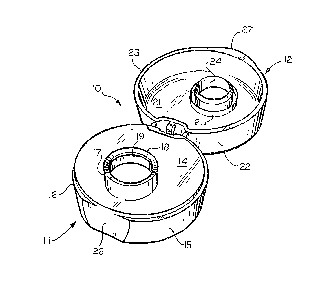Une partie des informations de ce site Web a été fournie par des sources externes. Le gouvernement du Canada n'assume aucune responsabilité concernant la précision, l'actualité ou la fiabilité des informations fournies par les sources externes. Les utilisateurs qui désirent employer cette information devraient consulter directement la source des informations. Le contenu fourni par les sources externes n'est pas assujetti aux exigences sur les langues officielles, la protection des renseignements personnels et l'accessibilité.
L'apparition de différences dans le texte et l'image des Revendications et de l'Abrégé dépend du moment auquel le document est publié. Les textes des Revendications et de l'Abrégé sont affichés :
| (12) Brevet: | (11) CA 1321775 |
|---|---|
| (21) Numéro de la demande: | 1321775 |
| (54) Titre français: | ELEMENT DE FERMETURE A CAPE |
| (54) Titre anglais: | CLOSURE WITH SNAP TYPE HINGE |
| Statut: | Périmé et au-delà du délai pour l’annulation |
| (51) Classification internationale des brevets (CIB): |
|
|---|---|
| (72) Inventeurs : |
|
| (73) Titulaires : |
|
| (71) Demandeurs : |
|
| (74) Agent: | GOWLING WLG (CANADA) LLP |
| (74) Co-agent: | |
| (45) Délivré: | 1993-08-31 |
| (22) Date de dépôt: | 1988-09-29 |
| Licence disponible: | S.O. |
| Cédé au domaine public: | S.O. |
| (25) Langue des documents déposés: | Anglais |
| Traité de coopération en matière de brevets (PCT): | Non |
|---|
| (30) Données de priorité de la demande: | ||||||
|---|---|---|---|---|---|---|
|
16275
CLOSURE WITH SNAP TYPE HINGE
Abstract of the Disclosure
A closure with a snap type hinge cap comprising a
first part adapted to interengage with the open neck of a
container and a second part forming a cap. Each of the first
and second parts comprises a base wall and a peripheral skirt.
A pair of hinges extends between the skirt of the first part
and the skirt of the second part to hinge the parts about a
hinge line. A short strap connects the skirt of the first part
and the skirt of the second part circumferentially between the
hinges. The short strap is axially rigid and has its ends
hinged to the skirt of the first part and the skirt of the
second part, respectively. The radial length of the strap is
less than the length of the arc through which the second cap
part is guided for movement by the hinges to and from open and
closed positions relative to the first part. The portion of
the skirt of the second part to which the strap is connected
is capable of flexing. The strap causes the flexing skirt of
the second part to deflect while rotating between open and
closed positions by pulling the skirt against its normal path.
The reaction of the skirt to this pulling action is to tend to
force the second part to remain open, or to tend to close the
second part after sufficient rotation is made in the closing
motion.
Note : Les revendications sont présentées dans la langue officielle dans laquelle elles ont été soumises.
Note : Les descriptions sont présentées dans la langue officielle dans laquelle elles ont été soumises.

2024-08-01 : Dans le cadre de la transition vers les Brevets de nouvelle génération (BNG), la base de données sur les brevets canadiens (BDBC) contient désormais un Historique d'événement plus détaillé, qui reproduit le Journal des événements de notre nouvelle solution interne.
Veuillez noter que les événements débutant par « Inactive : » se réfèrent à des événements qui ne sont plus utilisés dans notre nouvelle solution interne.
Pour une meilleure compréhension de l'état de la demande ou brevet qui figure sur cette page, la rubrique Mise en garde , et les descriptions de Brevet , Historique d'événement , Taxes périodiques et Historique des paiements devraient être consultées.
| Description | Date |
|---|---|
| Le délai pour l'annulation est expiré | 2002-09-03 |
| Lettre envoyée | 2001-08-31 |
| Accordé par délivrance | 1993-08-31 |
Il n'y a pas d'historique d'abandonnement
| Type de taxes | Anniversaire | Échéance | Date payée |
|---|---|---|---|
| TM (catégorie 1, 4e anniv.) - générale | 1997-09-02 | 1997-07-11 | |
| TM (catégorie 1, 5e anniv.) - générale | 1998-08-31 | 1998-07-06 | |
| TM (catégorie 1, 6e anniv.) - générale | 1999-08-31 | 1999-07-02 | |
| TM (catégorie 1, 7e anniv.) - générale | 2000-08-31 | 2000-07-04 |
Les titulaires actuels et antérieures au dossier sont affichés en ordre alphabétique.
| Titulaires actuels au dossier |
|---|
| OWENS-ILLINOIS CLOSURE INC. |
| Titulaires antérieures au dossier |
|---|
| WILLIAM E. FILLMORE |